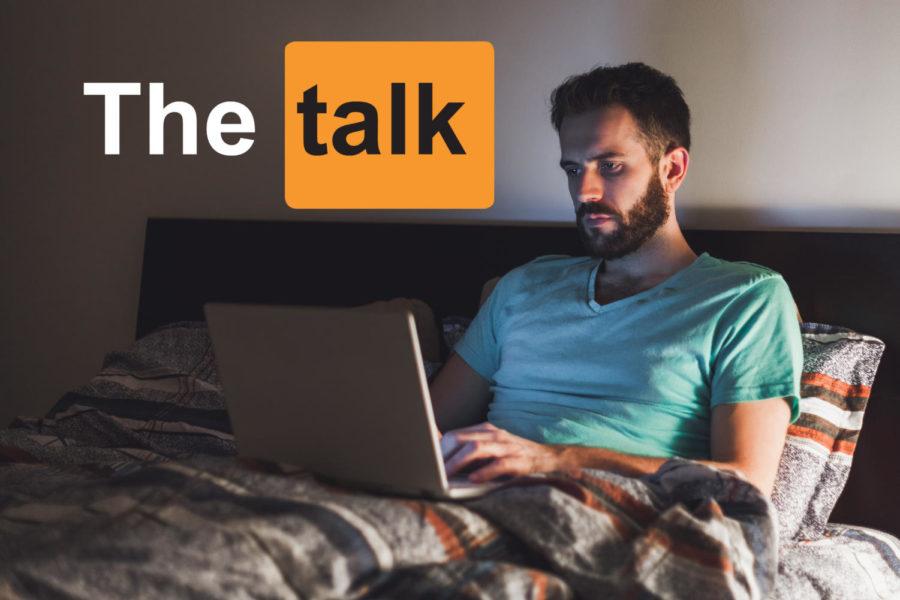The Talk: The impact pornography can have on you
the talk: porn
March 14, 2019
Editor’s note: This is part five in our weekly sex and culture series “The Talk.” Sensitive content may follow.
Pornography is a controversial subject not often discussed in school or at home. The average age of first exposure to pornography is around 11 years old, meaning it can be a prevalent part of young people’s lives and should not be a foreign topic of discussion, according to the Huffington Post post article “Parenting in the digital age of pornography.”
In 2018, Pornhub alone had 33.5 billion visits to its site and 92 million daily visits on average, according to Pornhub’s 2018 year in review. The United States ranks highest for Pornhub’s daily traffic.
In simpler words: The world of pornography is huge. It consists of a wide variety of categories and can be found digitally and in print. It often replaces sexual education due to the curiosity left behind after sexual education in schools leaves students with unanswered questions.
Sexual education in schools is rather simple, modest and lacking of diversity. Children and teenagers almost always receive an abstinence-based, cisgender and heterosexual perspective.
Those children and teenagers will search for answers to their questions, and a common source they look at is pornography because it is readily available. What they find are unrealistic body standards and expectations.
“After some gains by the Obama administration to promote more comprehensive sex ed, which includes pregnancy prevention, discussions of anatomy, birth control, disease prevention, abstinence and healthy relationships, the Trump administration did not include the program in its proposed 2018 budget; it also has requested increased funding for abstinence education, according to a New York Times Magazine article.
Easy-to-access online porn fills the vacuum, making porn the de-facto sex educator for American youth.
What young people learn from pornography is often carried with them as they go off to college and beyond.
There are several harmful effects on those who view pornography, according to Educate Empower Kids. A few examples are the inability to maintain meaningful and satisfying real-life relationships, objectifying women and a low self-esteem.
The New York Times Magazine evaluated some of the standards and confusions resulting from pornography in their article.
One of the teenagers in the article, who went by Drew, said he learned from porn that men are meant to be dominant and aggressive while the women are submissive and attracted to the dominance, aggression and confidence the men display. This plays into the objectification of women and gender roles in society.
Along with behavioral standards there are the physical standards in pornography. The men often have a muscular build and other masculine features. The women tend to be skinny and petite, usually with larger breasts.
Another teenager, who went by Q, talked about performance anxiety.
“‘You are looking at an adult,’ he told me. ‘The guys are built and dominant and have a big penis, and they last a long time. And if you don’t do it like the guys in porn,’ Drew added, ‘you fear she’s not going to like you,’” according to the New York Times Magazine article.
The article looked at how pornography makes women feel. Q talked about how men and boys watch pornography and are unsure of what their partners want in real life. Q brought up the point that women and girls might not know either.
“I think social media makes girls think they want something … but I think some of the girls are afraid,” Q said.
Pornography also contributes to the fetishizing of specific groups of people. These groups of people include but are not limited to those in the LGBTQIA+ community, teenagers and people of different ethnicities.
“I think it’s important to notice that many marginalized groups are actually fetishized within porn,” said Amy Popillion, a senior lecturer of human development and family studies. “People can be very harsh toward those groups in real life, but they’re watching that type of porn.”
Progress has been made for marginalized groups throughout the decades but pornography reverses that progress by presenting them as objects for sexual pleasure rather than people.
It’s no secret pornography is surrounded by a great deal of stigma and contains negative characteristics. However, there is ethical or fair-trade pornography out there.
According to Mel Magazine, David Ley, a clinical psychologist and author specializing in sexuality, defines ethical pornography as porn that holds true to these components: legally made, respects the rights of performers, pays performers for their labor, respects the copyright of the producer, shows both fantasy sex and real-world sex, is as diverse as the people consuming it, celebrates the diversity of sexuality and treats both performers and consumers of porn as free, consenting, thinking and powerful beings.
An example of an ethical pornography website is MakeLoveNotPorn (MLNP). According to their website they are “Pro-sex. Pro-porn. Pro-knowing the difference.” The difference between pornography and their content is “Porn is performative, manufactured entertainment. If porn is the Hollywood blockbuster movie, MLNP is the documentary.”
Other websites have features that identify ethically made pornography such as PornHub’s User Verification program, which means the content from verified users is legal, everyone is of legal age and everything is consensual. Viewers can also search the websites they use for a consent policy or look into the companies producing the content.
There are varying opinions on pornography. Some people are fully anti-porn and others are on the opposite side.
“I try to push continuous self-reflecting on your own use and how that’s impacting you, communicating with your partner about it and learning how to be an informed consumer,” Popillion said.







